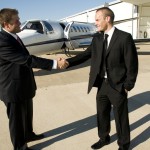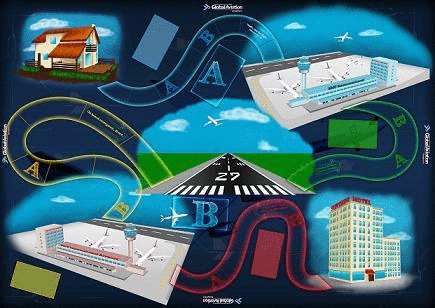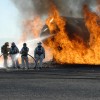Airline vs. Executive Aviation
[audio:https://aviationenglishblog.com/wp-content/uploads/2010/09/Airline_vs.executive_aviation-1.mp3|titles=Airline_vs.executive_aviation (1)]TOPIC: Airline vs. executive aviation
GOAL: To compare airline flying versus working in executive aviation
Exercise #1: Read about the differences between airline flying and executive aviation and then proceed to Exercise #2
The physical aspects of flying an airplane are fairly similar in most segments of the aviation industry. However, the overall economic scope and nature of this flying can be quite different, depending on the segment. A good case is the comparison between executive/business aviation and the airline market. Both operate a range of turboprop and jet aircraft but their use and customer base is very different.
So, we know that the typical airline passenger is the casual traveler, and frequently, a businessman/woman flying to a major market. But who uses business aviation? The answer is: companies and individuals seeking a fast, hassle-free option of air travel. While companies that rely on business aviation represent many different professions and locations, they all have one thing in common: the need for fast, flexible, safe, secure and cost-effective access to destinations across their country and around the world. Business aircraft allow employees to make a trip involving stops at several locations, then return to headquarters the same day. Hundreds or thousands of dollars can be saved on hotel rooms, rental cars, meals and other expenses that would be needed to make the same trip over several days via auto, train or airline transport. Because employees can meet, plan and work with each other aboard business aircraft, productivity en route is greatly enhanced.
 In many instances, business aviation is the best or only transportation option available, opening the door to global commerce for small-community and rural populations by linking them directly to population centers and manufacturing facilities. Studies have also shown that business aviation contributes greatly to local economies across the country.
In many instances, business aviation is the best or only transportation option available, opening the door to global commerce for small-community and rural populations by linking them directly to population centers and manufacturing facilities. Studies have also shown that business aviation contributes greatly to local economies across the country.
From the perspective of the pilot, each segment offers a different pace of work and the number of non-flying duties that pilots have depends on the employment setting. Airline pilots have the services of large support staffs and, consequently, perform few non-flying duties. However, because of the large numbers of passengers, airline pilots may be called upon to coordinate handling of disgruntled or disruptive passengers. Also, under the U.S. Federal Flight Deck Officer program airline pilots who undergo rigorous training and screening are deputized as Federal law enforcement officers and are issued firearms to protect the cockpit against intruders and hijackers.
 On the other hand, pilots employed by other organizations, such as charter operators or businesses, have many other duties. They may load the aircraft, handle all passenger luggage to ensure a balanced load, and supervise refueling; other non-flying responsibilities include keeping records, scheduling flights, arranging for major maintenance, and performing minor aircraft maintenance and repairs.
On the other hand, pilots employed by other organizations, such as charter operators or businesses, have many other duties. They may load the aircraft, handle all passenger luggage to ensure a balanced load, and supervise refueling; other non-flying responsibilities include keeping records, scheduling flights, arranging for major maintenance, and performing minor aircraft maintenance and repairs.
Exercise #2: Listen to audio; watch video, and then proceed to Exercise #3:
- NBAA President and CEO Ed Bolen discusses key issues for the executive aviation industry. Listen to the audio.
- NBAA's Ed Bolen Makes Case for Business Aviation at House Hearing. Video
- A video tour of the Airbus A318 Elite Business Jet’s luxurious cabin.
Exercise #3: Matching
Following each industry term or description, select whether it belongs to the airline or executive aviation market.
1. Tourist/casual traveler
a) Airline
b) Executive Aviation
2. Access to rural areas
a) Airline
b) Executive Aviation
3. Pilot expected to do many non-flying duties such as load baggage
a) Airline
b) Executive Aviation
4. In the U.S., these pilots undergo firearms training.
a) Airline
b) Executive Aviation
5. Business travelers mostly use this segment to fly to major markets.
a) Airline
b) Executive Aviation
6. Allows people to make a trip involving stops at several locations, then return to headquarters the same day.
a) Airline
b) Executive Aviation
7. These pilots have the services of large support staffs and, consequently, perform few non-flying duties.
a) Airline
b) Executive Aviation
Answers
1) a
2) b
3) b
4) a
5) a
6) b
7) a
















Recent Comments